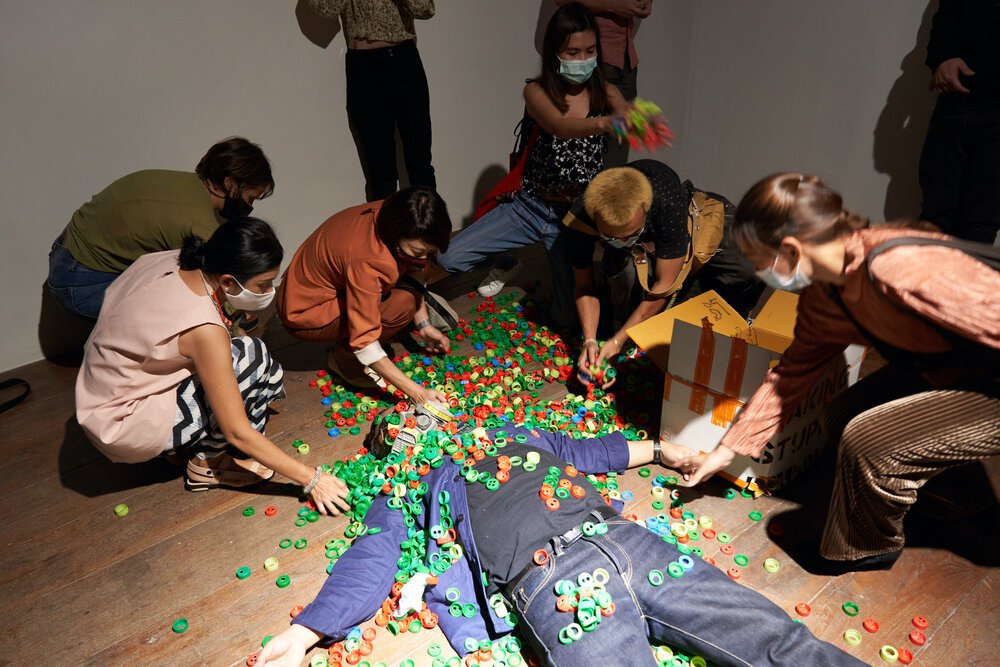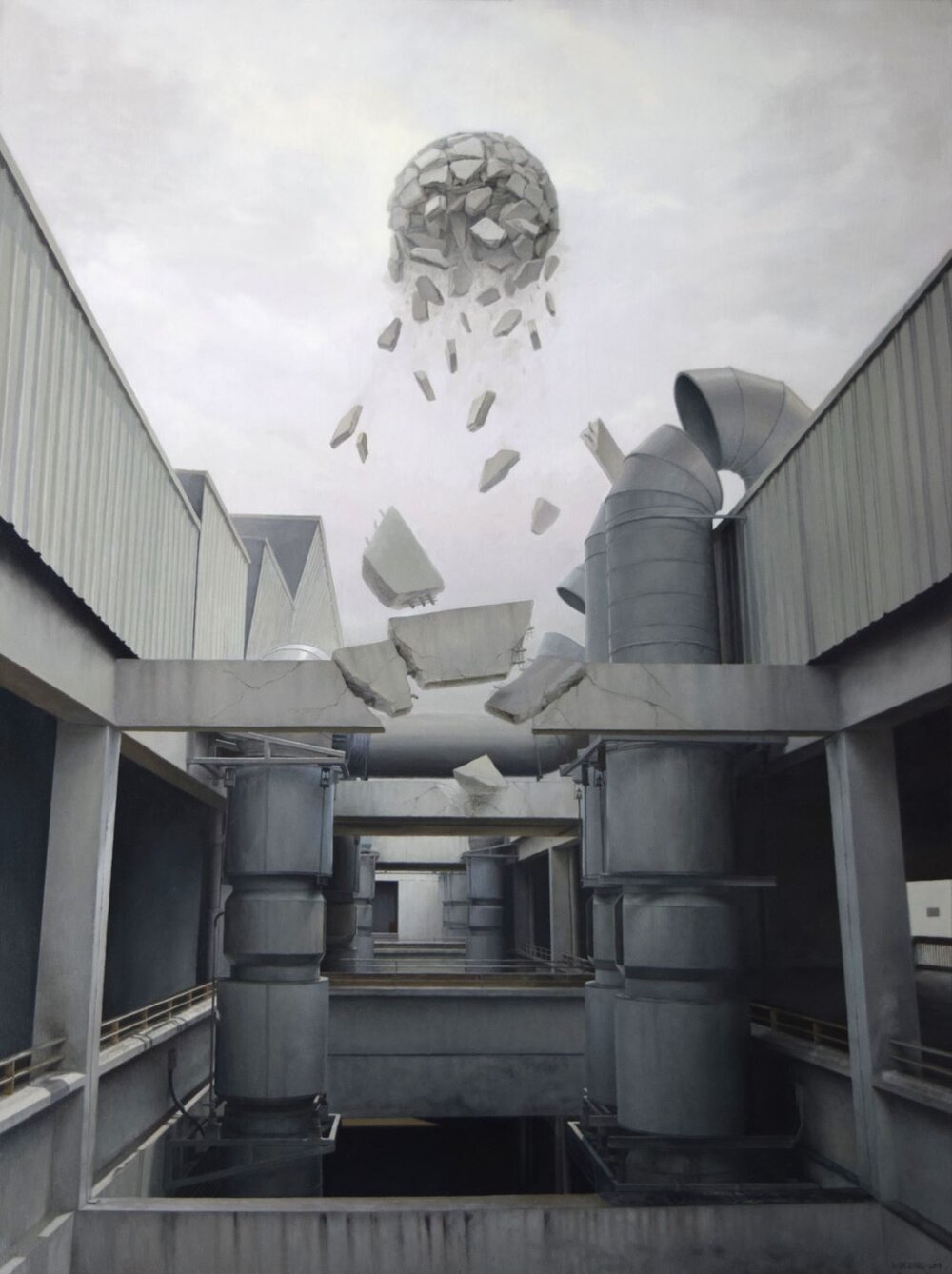Review of ‘SWAMPED’ at Warin Lab Contemporary
Examining the plastic waste problem through installation art
By Riley Yuen
The exhibition SWAMPED at the newly established Warin Lab Contemporary in Bangkok, Thailand explores the ideas of the circular economy, the evasion of blame for plastic pollution, and a disconnect from collective humanity. The show features artists Taweesak Molsawat, Thanawat Maneewa, Ploenchan Vinyaratn and Note Panayanggool across several disciplines and mediums in Warin Lab Contemporary’s first show, which opened on 24 February and will run until 21 April.
Taweesak Molsawat, performance documentation, 2021. Image courtesy of Warin Lab Contemporary.
Launched by Sukontip Fon Prahanpap, founder of La Lanta Contemporary in Bangkok, Warin Lab Contemporary is a new arts space committed to engaging with contemporary issues. La Lanta emphasizes the aesthetic in its curations but Warin Lab Contemporary has a different agenda. Prahanpap says, “Here, the opportunity is open for curators and artists to push the boundaries in genre-bending and experimenting programmes.” It is focused on creating space for conversation through art, aiming to incite and enable change, and to communicate pressing social issues.
In its first year, Warin Lab Contemporary aims to engage with several issues surrounding the environment and the interconnected influence of humans in the rapid deterioration of the natural world. The space aims to address the extinction of animal species, air quality and excess consumption with various artists from around the world before the end of the year. SWAMPED is the first of several exhibitions, tackling the issue of plastic waste.“To create social changes, the public has to be mobilised,” explains Prahanpap. “Art is a versatile communication tool to reach people through a different approach. It provokes the viewer to consider the issues and look into their own actions.” Warin Lab Contemporary uses art as a language to reach people of different educational backgrounds, generations and socioeconomic statuses.
‘SWAMPED’ (2021) at Warin Lab Contemporary, exhibition installation view. Image courtesy of Warin Lab Contemporary
Its debut exhibition, ‘SWAMPED’ was created by four artists Thanawat Maneenawa, Ploenchan Vinyaratn, Taweesak Molsawat and Note Panayanggool, together with Pongpan Suriyapat and Prahanpap as curators. The curation was inspired by the idea of the circular economy, an economic model developed in the 1990s that has been co-opted in several Western countries. It emphasises the consumerist cycle of reuse, sharing, refurbishment and upcycling. In this process, materials are reused and eliminate the excessive waste of single-use plastics. By creating a material circulation, general waste is reduced.
The idea of the circular economy is embodied in Warin Lab Contemporary’s own philosophy through their refurbished furniture and second-hand sound systems and air-conditioning units. Warin Lab Contemporary lives and breathes the practice of minimalist consumption, complementing the artists’ works well. In curating this exhibition surrounding the issue of excessive trash, Pongpan, co-curator and exhibition designer, reached out to several local companies to ask for trash donations. These donations were used as materials in the artworks, acting as both metaphorical inspiration and a literal tool for construction.
‘SWAMPED’ (2021) at Warin Lab Contemporary, exhibition installation view. Image courtesy of Warin Lab Contemporary.
At the start, the viewer is invited to think actively through the practice of path-making through the exhibition. With no clear end and beginning, the curation invites open discovery. Suriyapat elaborates, “Visitors are invited to experience each installation in no particular order. The essence is how much thought and messages they can take from the exhibition. This approach resonates with the loop of the waste… The exhibition poses an open-ended question for the visitors to decide for themselves.” The exhibition follows a “cause-result-solution” narrative, which is explained by the three visual artists, Ploenchan, Thanawat and Taweesak through their art.
Upon viewing the show, one is confronted immediately by the sheer volume of material. Trash is scattered across the floor and overwhelms the walls in both disorganised piles and poised assemblages. This visual impact creates a jarring, totalising experience that communicates the issues of waste and trash in the world in a very direct manner.
Thanawat Maneenawa, Human Faces in “SWAMPED” art installation, 2021, found objects, dimensions variable. Image courtesy of Warin Lab Contemporary.
The cause of excessive waste as identified by Thanawat Maneewa reflects on human behaviors and as the viewer observes the work, the whimsical faces stare back, meant to encourage introspection in one’s own consumption and waste. The materials for these faces have been collected at deposits for plastic waste at various locations. Maneewa wishes to bring attention to the way that plastic is often vilified as the culprit for excessive pollution but it is, in fact, the actions of humans that have resulted in overwhelmed landfills. Upon further inspection, the constructed faces seem eerie as a condemnation of wasteful actions that we all practice.
Ploenchan Vinyaratn, Heap in “SWAMPED” art installation, 2021, found objects. Image courtesy of Warin Lab Contemporary.
The result of creating waste is seen in Ploenchan Vinyaratn’s woven work, which looms in the centre of the room and its indomitable presence demands attention. The textile is made entirely of waste donations and highlights the sheer amount of trash. As one approaches, the materials of metal cans and plastic strips reveal themselves. She underscores how trash can be ‘beautiful’, an unlikely perspective. While the medium of textile conveys feelings of warmth and comfort, the materiality of trash creates an interesting dynamic between an appreciation for its craftsmanship alongside an unnerving understanding of the results of excessive consumption.
Taweesak Molsawat, installation view of ‘Body Politic/Object Politic: Still (A)Li(v/f)e’, 2021, found objects, dimensions variable. Image courtesy of Warin Lab Contemporary.
Taweesak Molsawat engages with mediums of performance and installation in his work that aims to decipher a solution for the excessive amount of trash. In his delicate assemblages, trash is repurposed into beautiful sculptures that attract the viewer. Molsawat’s performance piece also relies heavily on viewer participation and is meant to bring attention to the fact that humans do not exist in relation to material objects, but in relation to each other. In his work, he aims to disorient the viewer by deconstructing their cultural and social ties and creating new experiences and connections through the artist’s body and his performance. He tunes the audience’s consciousness to their existence as part of a community in spite of the isolating factors of modernism and technological advancements.
Taweesak Molsawat, ‘Body Politic/Object Politic: Still (A)Li(v/f)e’, 2021, found objects, dimensions variable. Image courtesy of Warin Lab Contemporary.
As the viewer moves around the exhibition, Note Panayanggool’s audio work changes and reacts to their movement, making the viewer hyper-aware of their own bodily materiality. She focuses the viewer’s attention to the fact that each individual action of a human has resounding effects. This is a lesson that can be taken outside of the exhibition’s walls and will hopefully invite visitors to be more mindful of the waste that they generate.
This exhibition highlights the complex relation between the humans and the environment. Prahanpap says, “The exhibition sets out to create the emotional connection of inundation, besiegement and concern. From these psychological confrontations, I hope to stimulate the viewer to think about their own lifestyle and make positive changes in regards to reducing plastic pollution.” This exhibition is an invitation for introspection, pushing the viewer to confront their own daily practices and how their actions could be adversely affecting the world.
Taweesak Molsawat, ‘Body Politic/Object Politic: Still (A)Li(v/f)e’, 2021, found objects, dimensions variable. Image courtesy of Warin Lab Contemporary.
As the global consciousness turns to issues of sustainability and conservation, this exhibition beautifully articulates the issues of careless consumption and habitual pollution. Additionally, it is clear that Warin Lab Contemporary aims to embody the solutions that are proposed in the art that it exhibits. ‘SWAMPED’ accomplishes what it sets out to do: to rehumanise through a collective awareness of our own actions and to understand, as a community, that the issues, realities, and solutions to excessive consumption lie in humanity alone.
Click here for more information on Warin Art Lab.


















